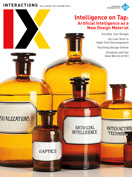Authors:
Maliheh Ghajargar
The growing interest in the Internet of Things and in technological, connected, and computing-enhanced spaces such as smart homes (Figure 1), intelligent environments, and responsive environments connects interaction design more and more with architecture. Everyday spaces such as home environments are increasingly filled with computing and smart objects. This trend of ubiquitous computing, as envisioned and pioneered by Mark Weiser at Xerox PARC, has since worked as a basis for designing smart environments—across people, objects, and spaces. Many researchers have further investigated how the flows and patterns of activities in a space can guide the design of interactions with…
You must be a member of SIGCHI, a subscriber to ACM's Digital Library, or an interactions subscriber to read the full text of this article.
GET ACCESS
Join ACM SIGCHIIn addition to all of the professional benefits of being a SIGCHI member, members get full access to interactions online content and receive the print version of the magazine bimonthly.
Subscribe to the ACM Digital Library
Get access to all interactions content online and the entire archive of ACM publications dating back to 1954. (Please check with your institution to see if it already has a subscription.)
Subscribe to interactions
Get full access to interactions online content and receive the print version of the magazine bimonthly.






